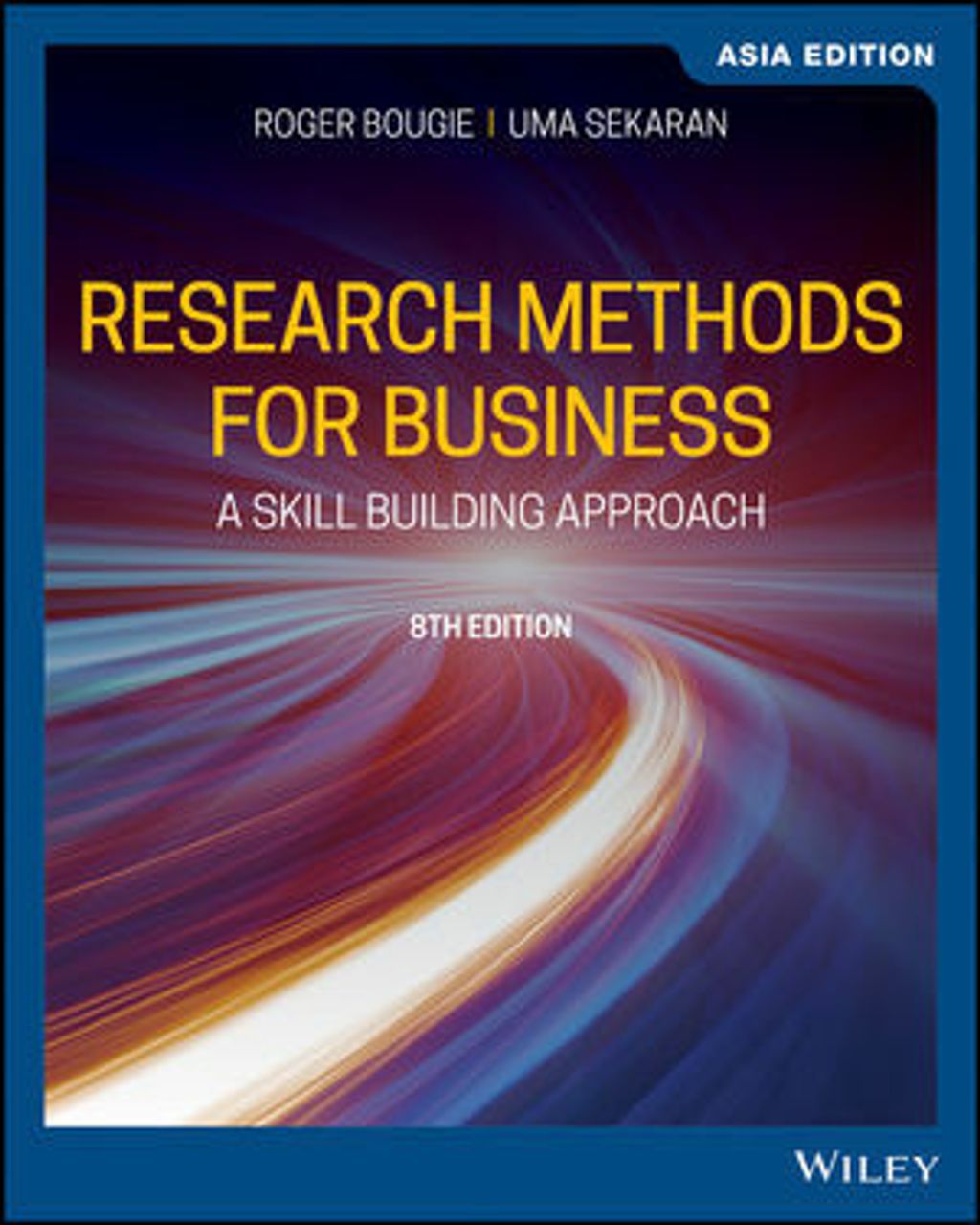
Research Methods For Business Uma Sekaran / Roger Bougie 8th AE 9781119683537
TITLE : Research Methods For Business - A Skill Building Approach Uma Sekaran / Roger Bougie
ISBN13 : 9781119683537
PUBLISHER : JOHN WILEY (2020)
EDITION : 11TH ASIAN EDITION PAPERBACK
PAGES : 396 PAGES
TABLE OF CONTENTS
About the Authors xxi
Preface xxiii
Acknowledgements xxv
1 Introduction to Research 1
Introduction 1
Types of Business Research: Applied and Basic 4
Managers and Research 7
Internal Versus External Consultants/Researchers 9
Knowledge about Research and Managerial Effectiveness 11
Ethics and Business Research 11
Summary 12
Discussion Questions 13
Case: The Laroche Candy Company 14
Case Questions 15
2 The Scientific Approach and Alternative Approaches to Investigation 16
Introduction 16
The Hallmarks of Scientific Research 17
The Hypothetico-Deductive Method 20
Alternative Approaches to Research 22
A Pragmatic Approach to Research 24
Summary 32
Discussion Questions 32
3 Defining the Management Problem 34
Introduction 34
Looking for Decision Opportunities or Areas for Improvement 35
Fixing Situations that are Broken 37
Providing Feedback to the Client Organization 46
Managerial Implications 46
Summary 47
Discussion Questions 48
Appendix: Background Information on the Organization 49
4 Defining the Research Problem 51
Introduction 51
The Management Problem 51
Defining the Research Problem 51
The Research Proposal 58
Managerial Implications 60
Ethical Issues in the Preliminary Stages of Investigation 61
Summary 62
Discussion Questions 62
5 The Critical Literature Review 64
Introduction 64
How to Approach the Literature Review 66
Ethical Issues 71
Summary 73
Discussion Questions 73
Practice Project 74
Appendix: Some Online Resources Useful for Business Research 75
6 Theoretical Framework and Hypothesis Development 83
Introduction 83
The Need for a Theoretical Framework 84
Variables 85
How Theory is Generated 92
7 Elements of Research Design 103
Introduction 103
The Research Design 103
Elements of Research Design 104
Mixed Methods 113
Trade-offs and Compromises 114
Managerial Implications 115
Summary 115
Discussion Questions 116
8 Interviews 117
Introduction 117
Primary Data Collection Methods 117
Interviews 118
Advantages and Disadvantages of Interviews 126
Summary 127
Discussion Questions 128
9 Observation 129
Introduction 129
Definition and Purpose of Observation 130
Four Key Dimensions that Characterize the Type of Observation 130
Two Important Approaches to Observation 132
Advantages and Disadvantages of Observation 139
Summary 141
Discussion Questions 141
10 Administering Questionnaires 143
Introduction 143
Types of Questionnaires 143
Guidelines for Questionnaire Design 146
International Dimensions of Surveys 155
Review of the Advantages and Disadvantages of Different Data Collection Methods and When to Use Each 157
Multimethods of Data Collection 157
Managerial Implications 158
Ethics in Data Collection 158
Summary 159
Discussion Questions 160
11 Experimental Designs 164
Introduction 164
The Lab Experiment 166
The Field Experiment 170
External and Internal Validity in Experiments 170
Types of Experimental Design and Validity 177
Simulation 182
Ethical Issues in Experimental Design Research 182
Managerial Implications 183
Summary 184
Discussion Questions 185
Appendix: Further Experimental Designs 187
12 Measurement of Variables: Operational Definition 190
Introduction 190
How Variables are Measured 190
Operational Definition (Operationalization) 192
International Dimensions of Operationalization 196
Summary 196
Discussion Questions 197
13 Measurement of Variables: Scaling, Reliability and Validity 198
Introduction 198
Four Types of Scales 198
Rating Scales 202
Ranking Scales 207
International Dimensions of Scaling 208
Goodness of Measures 208
Reflective Versus Formative Measurement Scales 212
Summary 213
Discussion Questions 214
Appendix: Examples of Some Measures 216
14 Sampling 221
Introduction 221
Population, Element, Sample, Sampling Unit and Subject 222
Sample Data and Population Values 224
The Sampling Process 225
Probability Sampling 228
Non-Probability Sampling 232
Intermezzo: Examples of When Certain Sampling Designs Would Be Appropriate 236
Issues of Precision and Confidence in Determining Sample Size 241
Sample Data and Hypothesis Testing 244
The Sample Size 246
Sampling as Related to Qualitative Studies 249
Managerial Implications 250
Summary 250
Discussion Questions 252
15 Quantitative Data Analysis 254
Introduction 254
Getting the Data Ready for Analysis 255
Getting a Feel for the Data 260
Excelsior Enterprises: Descriptive Statistics Part 1 269
Testing the Goodness of Measures 270
Excelsior Enterprises: Descriptive Statistics Part 2 273
Summary 276
Discussion Questions 276
16 Quantitative Data Analysis: Hypothesis Testing 279
Introduction 279
Type I Errors, Type II Errors and Statistical Power 279
Choosing the Appropriate Statistical Technique 280
Excelsior Enterprises: Hypothesis Testing 300
Big Data Mining and Operations Research 302
Some Software Packages Useful for Data Analysis 303
Summary 304
Discussion Questions 304
17 Qualitative Data Analysis 307
Introduction 307
Three Important Steps in Qualitative Data Analysis 307
Reliability and Validity in Qualitative Research 319
Some Other Methods of Gathering and Analysing Qualitative Data 320
Big Data 321
Summary 321
Discussion Questions 322
18 Conclusions 323
Introduction 323
Conclusions and Recommendations: Where Your Journey as a Researcher Ends 324
Incorrect or Flawed Forms of Reasoning 332
Summary 334
Discussion Questions 335
19 The Research Report 337
Introduction 337
The Written Report 337
Contents of the Research Report 340
Oral Presentation 346
Summary 349
Discussion Questions 349
Appendix: Examples 350
Report 1: Sample of a Report Involving a Descriptive Study 350
Report 2: Sample of a Report offering Alternative Solutions and Explaining the Pros and Cons of Each Alternative 353
Report 3: Example of an Abridged Basic Research Report 355
A Final Note to Students 359
Statistical Tables 361
Glossary 371
Bibliography 381
Index 389
![ES EXTENSTION TRADING www.1tobuy.com [1TO BUY]](https://cdn.store-assets.com/s/406307/f/7859603.png?width=350)